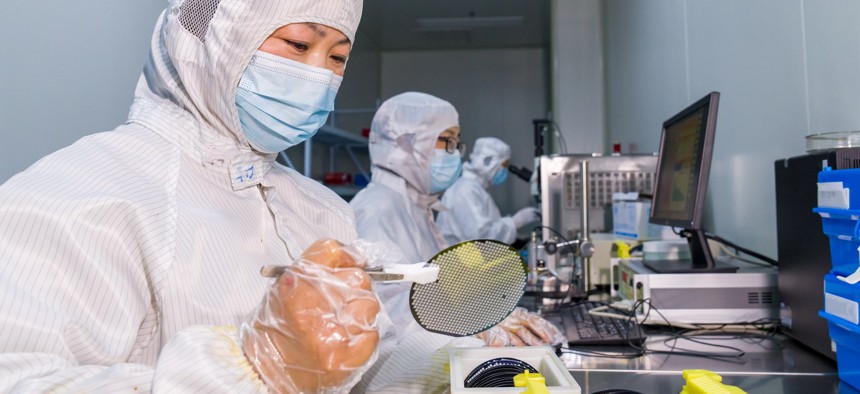
A worker makes and tests semiconductor power device chip products at a workshop of a microelectronics company in Binhai New Area, Hai 'an City, East China's Jiangsu Province, March 23, 2023. Costfoto / NurPhoto via Getty Images
China Is Gearing Up to Evade Chip-Export Rules
As one avenue for China to illicitly acquire high-end dual use technology dries up, watch for others to expand.
China has long relied on foreign-made computer chips for bleeding-edge national security efforts, from supercomputers to domestic surveillance to AI. Now, as American policymakers work to stem this flow of advanced technology, China is trying to accelerate its own chipmaking industry—and devising ways to circumvent export restrictions.
For over three decades, the business model used by Western companies made it easy for local middlemen to sell and resell pocket-sized supercomputer chips, smoothing their path to sanctioned organizations on the U.S. Entity List. For instance, Intel’s multi-core Xeon CPUs were used to build China’s Tianhe-2, the world’s fastest supercomputer as of 2013, owned by the National University of Defense Technology and used for a wide range of military research. This business model is made up of four parts: company sales and engineering staff and their senior management, who are almost all Chinese citizens; Chinese computer manufacturers such as Lenovo, Haier, and others, that purchase chips in bulk and sometimes resell them on the open market; the huge electronics emporiums throughout China, such as Huaqiang Electronics World in Shenzhen; and the electronics distributors (“distis”), that resell CPUs and GPUs throughout China. Semiconductor powerhouse AMD, for example, has 32 authorized distributors in China, most of which are smaller entities, while Intel has 11.
This model emphasizes maximizing sales per quarter, as company shareholders in any industry would expect. However, in doing so, it also weakens the guardrails meant to prevent tech transfer to PLA and other prohibited entities. Under this model, locally hired Chinese nationals pursue direct sales to big Chinese computer manufacturers like Lenovo, or sell to local electronics distributors. In the PRC, the sales managers who directly interact with Chinese end-users are themselves Chinese citizens, more beholden to Chinese law than they are to any corporate code of conduct.
This business model also provides an easy “in” for parties on the U.S. Entity List seeking clandestine transfer of technology. By using local middlemen, they have multiple opportunities to disguise purchases and thefts of sensitive technology. Most notoriously, these middlemen are likely also responsible for the recent proliferation of U.S. computer technology in North Korea.
The gap has narrowed since October, when new U.S. export controls began to prohibit the sale of the fastest chips and advanced semiconductor manufacturing equipment across China, not just to known entities working on weapons production. While local middlemen can still divert computer technology just below the cutting edge, the removal of the most advanced chips from the entirety of the Chinese market reduces the risk that these chips will be diverted by local middlemen from ostensibly civilian end-users to the military or surveillance state.
Beijing’s allies in Tehran and Pyongyang, however, provide contemporary examples of how a nation under international sanctions can use friendly business relations with third countries to evade U.S. sanctions. Iran recently developed the Simurgh supercomputer, built with U.S. components acquired illegally via third-party resellers and shell companies in the UAE, and even faraway Malaysia. Malaysia was also the home of Glocom, a North Korean company that sold military equipment until it was publicly exposed in 2017. North Korean firms quietly operated in Africa for decades before being discovered and sanctioned.
For China, one of the most important new avenues may be found in its near-abroad. Hong Kong is no longer a viable avenue for high-technology diversion. A loophole in U.S. controls on semiconductor exports to Macau’s burgeoning tech sector was finally closed in January. But Chinese tech firms are reportedly flowing into Singapore and other Southeast Asian nations amid a local renaissance in semiconductor manufacturing, at least partly to avoid U.S. sanctions.
Singapore is the world’s largest transshipment hub and long a neutral country, which has sometimes been exploited for the illegal reexport of controlled technology and dangerous goods. Examples include military-grade antennas and radio-frequency modules shipped to Iran in In 2013, and IEDs components in Iraq traced back to the island country in 2016. China has also made use of Singapore, including a 2021 case, in which a Chinese national was charged with criminal conspiracy by the U.S. Justice Department for smuggling power amplifiers to China via Singapore. Under this changing dynamic, the risk appears higher that China will shift some of its clandestine technology diversion operations related to microchips to Southeast Asia.
Unfortunately, the U.S. is underprepared for this challenge. The U.S. Commerce Department has a lone export control officer stationed there to cover all of Southeast Asia and Australia. It shows the need for U.S. regulators and agencies to be prepared for the larger game playing out within tech transfers and export controls.
Matt Brazil is a China Analyst with BluePath Labs and the co-author (with Peter Mattis) of Chinese Communist Espionage, An Intelligence Primer (2019). He is a former employee of the Commerce Department and of Intel Corporate Security. His views do not represent those of any institution.




